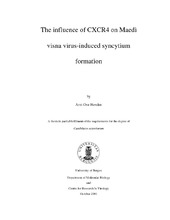| dc.contributor.author | Hovden, Arnt-Ove | eng |
| dc.date.accessioned | 2006-03-02T09:27:08Z | |
| dc.date.available | 2006-03-02T09:27:08Z | |
| dc.date.issued | 2001 | eng |
| dc.identifier.isbn | 82-8088-003-8 (electronic version) | en_US |
| dc.identifier.other | http://www.ub.uib.no/elpub/2001/h/402001/ | eng |
| dc.identifier.uri | https://hdl.handle.net/1956/1117 | |
| dc.description.abstract | Maedi visna virus (MVV) is a retrovirus that is member of the Lentivirus genus. MVV infects sheep and goats and causes progressive pneumonia or paralysis, leading to death. Since the discovery of the receptor for Human immunodeficiency virus (HIV), Simian immunodeficiency virus (SIV) and Feline immunodeficiency virus (FIV) all include the chemokine receptor CXCR4, it has been postulated that all members of the Lentivirus share a common mechanism of entry that involves the use of CXCR4. With the use of syncytia assays, infection-, inhibition- and enhancement studies, it was shown that CXCR4 is not a common lentivirus receptor. U87 and HOS cells, both celllines lacking CXCR4, were susceptible to infection. However, cells transfected with CD4 and CXCR4 showed an increased syncytia formation and the presence of CD¤ and CXCR4 augments virus-induced cell fusion. The nature of MVV receptor is still not known, but our data suggest the use of CD4 and/or CXCR4 as accessory molecules or as part of a receptor complex. | en_US |
| dc.format.extent | 716235 bytes | eng |
| dc.format.mimetype | application/pdf | eng |
| dc.language.iso | eng | eng |
| dc.publisher | The University of Bergen | en_US |
| dc.title | The influence of CXCR4 on Maedi visna virus-induced syncytium formation | en_US |
| dc.type | Master thesis | |
| dc.rights.holder | The author | en_US |
| dc.rights.holder | Copyright the author. All rights reserved | en_US |
| dc.subject.nsi | VDP::Matematikk og Naturvitenskap: 400::Basale biofag: 470::Molekylærbiologi: 473 | nob |
